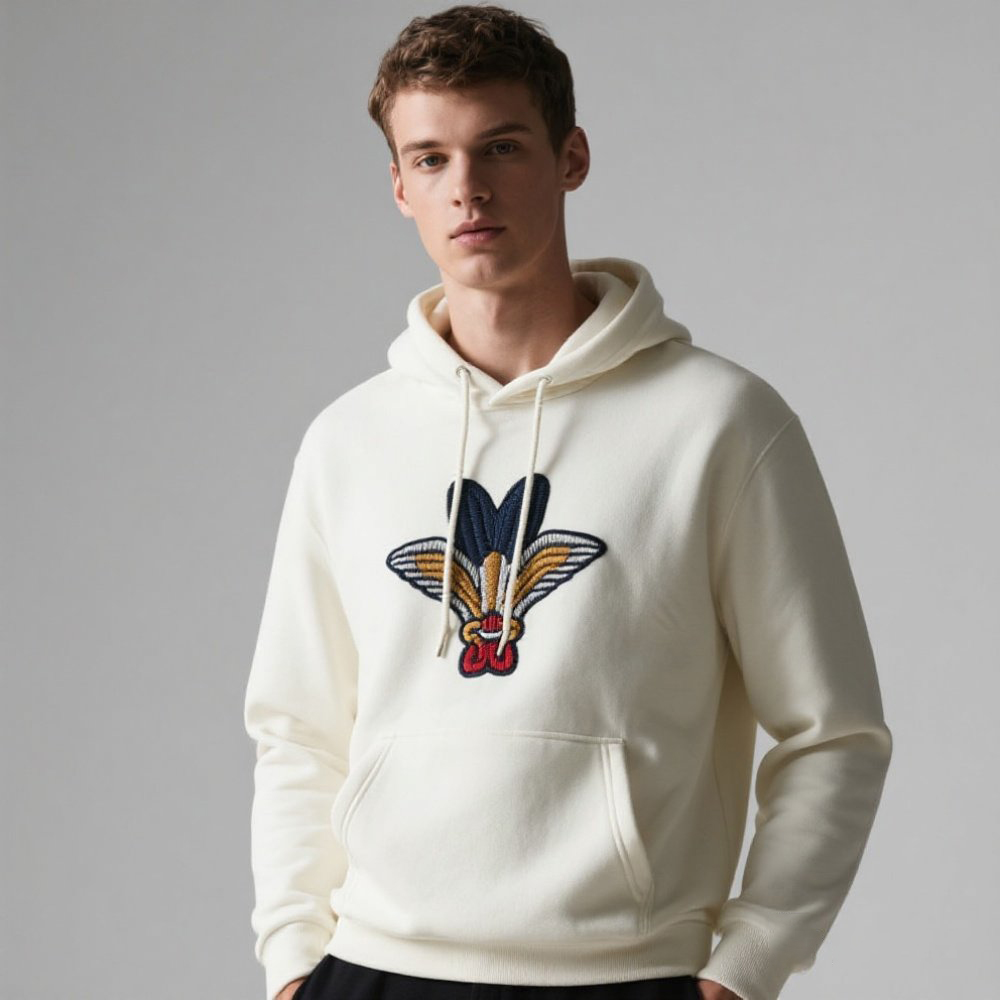— A Practical Guide for Startup Clothing Brands and Hoodie Buyers
Struggling to decide between cotton, polyester, or fleece for your hoodie collection? You‘re not alone. Choosing the right fabric is one of the most important steps in hoodie production—and one of the most misunderstood. The material you choose will determine not just how the hoodie feels, but how it prints, lasts, fits, and even how your brand is perceived. In this guide, we break down what fabric options are best for hoodies depending on season, customer base, and price point. If you’re sourcing hoodies for resale or launching your first winterwear line, this is for you.

Fabric Can Make or Break Your Hoodie Line
When it comes to hoodie production, your material choice isn’t just a technical detail—it’s the foundation of your product experience. A hoodie made with the wrong fabric can:
- Shrink or warp after just one wash,
- Pill and fade within weeks,
- Or worse—feel rough, stiff, or cheap when your customer puts it on.
At Sheen, we’ve worked with over 200 apparel brands across the US and Europe. One of the most common issues new buyers face is choosing the wrong material for their market—and paying the price in customer complaints, high return rates, or poor reviews. The right fabric can position your hoodie as premium, durable, and comfortable. The wrong one? A clearance rack item within a season.
The Most Common Hoodie Fabrics and How to Choose
Let’s break down the most widely used hoodie materials and their pros, cons, and best use cases.
1. 100% Cotton Hoodies
Best for: Natural feel, breathability, boutique brands
GSM Range: 280–360
Pros:
- Soft and breathable
- Easy to dye and print
- Premium look and feel
Cons:
- Tends to shrink if not pre-washed
- Less durable than blends in long-term wear
- Can fade or lose shape over time
At Sheen, we recommend 100% cotton for high-end lifestyle or streetwear brands where look and comfort are top priority—and where proper washing care can be expected from the end customer.
2. Cotton-Polyester Blends (e.g., 65% Cotton / 35% Polyester)
Best for: All-season hoodies, winterwear, high durability
GSM Range: 300–380
Pros:
- Combines comfort of cotton with resilience of polyester
- More shrink-resistant
- Holds shape and color longer
- Ideal for printing and embroidery
Cons:
- Slightly less breathable than pure cotton
- May feel synthetic if the polyester content is too high
This is the most popular blend we produce for winter hoodies at Sheen. It‘s the sweet spot for comfort, warmth, and durability—especially when brushed fleece lining is added.
3. Fleece (Brushed Inside)
Best for: Cold-weather hoodies, sportswear, cozy loungewear
Common Materials: Cotton-poly blend with brushed inner
Pros:
- Super soft inside
- Excellent insulation
- Ideal for cold-weather layering
Cons:
- Can feel bulky for slim-fit styles
- May pill over time if low quality
If your customers expect warmth and comfort, fleece-backed hoodies are a must. At Sheen, we recommend fleece-backed blends for GSM over 320 for winter collections.
4. French Terry
Best for: Lightweight hoodies, spring/summer wear
Common Composition: Cotton or cotton-blend
Pros:
- Loopback interior—smooth on outside, breathable on inside
- Great for layering
- Soft but structured drape
Cons:
- Less insulating than fleece
- May not feel “thick enough” for colder climates
French terry is great for gym, activewear, or transitional seasons. Several of our US clients use this for their midweight capsule collections.
5. Recycled or Sustainable Blends
Best for: Eco-conscious brands or storytelling collections
Common Types: Recycled polyester, organic cotton, bamboo fiber
Pros:
- Sustainability story can boost brand image
- Feels premium when sourced well
- Marketing edge for Gen Z buyers
Cons:
- Higher material cost
- Requires careful supplier vetting for true certification
- May not be as durable as blended fleece
At Sheen, we now offer GOTS-certified organic cotton and RPET-blended fleece options for brands building eco lines. MOQ starts at 500 pcs/style.
How to Match Material to Your Brand and Customer
If you’re not sure which material to choose, start by asking:
1. Where will this hoodie be worn?
- Cold climate? Go 320+ GSM brushed fleece blend
- Year-round wear? Consider French terry or lighter fleece
- Athleisure? Use midweight blends with stretch
2. What does your customer care about?
- Comfort? Cotton and fleece win
- Durability? Go for a cotton-poly blend
- Sustainability? Try organic cotton or recycled blends
3. What‘s your price positioning?
- Budget: Cotton-poly blend (more affordable)
- Mid-tier: 100% cotton or fleece
- Premium: Organic cotton, heavy GSM fleece, custom knitting
At Sheen, we help brands not only select the fabric but test it through samples, wash tests, and fit trials before full production. We know how important it is to match material with both your price and market expectations.
Request Your Fabric Samples and Start Prototyping
Choosing your hoodie fabric doesn’t have to be overwhelming. We’ve curated a reliable selection of hoodie materials that balance feel, performance, and price.
Here’s what you can do now:
✅ Request our material swatch pack (includes fleece, French terry, cotton-poly blends, and eco fabrics)
✅ Send us your tech pack or hoodie idea—we‘ll help you match the right fabric to your target market
✅ Order samples within 7–10 days (EXW)
✅ Full production lead time: 25–35 days EXW
Contact Sheen now and let us help you build your hoodie collection from the fabric up. Whether you’re just testing or ready to go full scale, our team is here to make your sourcing smarter.
Next Topic: What Fabric Options Are Available for Custom Hoodies?
Choosing a fabric isn’t just about warmth or softness—it’s about matching your hoodie’s function, style, and market expectations. Whether you’re creating a premium streetwear drop, a budget-friendly promotional hoodie, or a sustainable capsule collection, fabric selection plays a major role in how your brand is perceived.
In our next post, we’ll break down all the fabric options available for custom hoodie production—from heavyweight fleece to French terry, organic cotton, and recycled blends. You’ll learn how to align GSM, texture, and fiber content with your budget and brand story, and how Sheen helps you test and compare before placing a bulk order.
Stay tuned—your perfect fabric might be just one blog away.
Final Thoughts
Fabric choice is the backbone of your hoodie’s quality. It affects everything: how your hoodie wears, how it lasts, how customers feel about your brand. At Sheen, we’ve helped hundreds of brands avoid production mistakes by starting with the right material—and we’re here to help you do the same.
Let‘s build better hoodies, together. Reach out now to start sampling your ideal hoodie fabric.
👉[Insert contact link] | MOQ from 300 pcs/style | Global shipping | Fabric testing included

